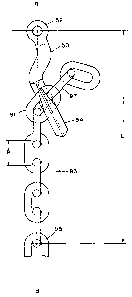Une partie des informations de ce site Web a été fournie par des sources externes. Le gouvernement du Canada n'assume aucune responsabilité concernant la précision, l'actualité ou la fiabilité des informations fournies par les sources externes. Les utilisateurs qui désirent employer cette information devraient consulter directement la source des informations. Le contenu fourni par les sources externes n'est pas assujetti aux exigences sur les langues officielles, la protection des renseignements personnels et l'accessibilité.
L'apparition de différences dans le texte et l'image des Revendications et de l'Abrégé dépend du moment auquel le document est publié. Les textes des Revendications et de l'Abrégé sont affichés :
| (12) Brevet: | (11) CA 2083989 |
|---|---|
| (54) Titre français: | CROCHET PRENEUR POUR CHAINE ET PERMETTANT DE REGLER PARTIELLEMENT LE MAILLON |
| (54) Titre anglais: | GRAB HOOK FOR ATTACHMENT TO A CHAIN TO PROVIDE PARTIAL LINK ADJUSTMENT |
| Statut: | Durée expirée - au-delà du délai suivant l'octroi |
| (51) Classification internationale des brevets (CIB): |
|
|---|---|
| (72) Inventeurs : |
|
| (73) Titulaires : |
|
| (71) Demandeurs : |
|
| (74) Agent: | LAMBERT INTELLECTUAL PROPERTY LAW |
| (74) Co-agent: | |
| (45) Délivré: | 2003-05-06 |
| (22) Date de dépôt: | 1992-11-27 |
| (41) Mise à la disponibilité du public: | 1994-05-28 |
| Requête d'examen: | 1999-10-26 |
| Licence disponible: | S.O. |
| Cédé au domaine public: | S.O. |
| (25) Langue des documents déposés: | Anglais |
| Traité de coopération en matière de brevets (PCT): | Non |
|---|
| (30) Données de priorité de la demande: | S.O. |
|---|
A hook for gripping chain is asymmetrical so
that the effective chain length can be adjusted to a part
link tightness. The attachment end of the hook is offset
from the plane of the hook end, which includes the slot
for receiving a link of a chain. If the chain enters from
one side of the hook, the chain and hook nave a different
angle than when the chain enters from the other side of
the hook. The resulting change in angle and hence the way
the hook interferes with the chain changes the length of
chain required for the chain to reach the slot.
Note : Les revendications sont présentées dans la langue officielle dans laquelle elles ont été soumises.
Note : Les descriptions sont présentées dans la langue officielle dans laquelle elles ont été soumises.

2024-08-01 : Dans le cadre de la transition vers les Brevets de nouvelle génération (BNG), la base de données sur les brevets canadiens (BDBC) contient désormais un Historique d'événement plus détaillé, qui reproduit le Journal des événements de notre nouvelle solution interne.
Veuillez noter que les événements débutant par « Inactive : » se réfèrent à des événements qui ne sont plus utilisés dans notre nouvelle solution interne.
Pour une meilleure compréhension de l'état de la demande ou brevet qui figure sur cette page, la rubrique Mise en garde , et les descriptions de Brevet , Historique d'événement , Taxes périodiques et Historique des paiements devraient être consultées.
| Description | Date |
|---|---|
| Exigences relatives à la révocation de la nomination d'un agent - jugée conforme | 2020-04-22 |
| Exigences relatives à la nomination d'un agent - jugée conforme | 2020-04-22 |
| Inactive : Périmé (brevet - nouvelle loi) | 2012-11-27 |
| Inactive : TME en retard traitée | 2011-02-14 |
| Inactive : Demande ad hoc documentée | 2011-01-28 |
| Lettre envoyée | 2010-11-29 |
| Accordé par délivrance | 2003-05-06 |
| Inactive : Page couverture publiée | 2003-05-05 |
| Préoctroi | 2003-02-20 |
| Inactive : Taxe finale reçue | 2003-02-20 |
| Un avis d'acceptation est envoyé | 2002-12-10 |
| Un avis d'acceptation est envoyé | 2002-12-10 |
| Lettre envoyée | 2002-12-10 |
| Inactive : Approuvée aux fins d'acceptation (AFA) | 2002-11-21 |
| Modification reçue - modification volontaire | 2002-10-17 |
| Inactive : Dem. de l'examinateur par.30(2) Règles | 2002-09-23 |
| Modification reçue - modification volontaire | 2000-02-24 |
| Inactive : Dem. traitée sur TS dès date d'ent. journal | 1999-11-26 |
| Lettre envoyée | 1999-11-26 |
| Inactive : Renseign. sur l'état - Complets dès date d'ent. journ. | 1999-11-26 |
| Exigences pour une requête d'examen - jugée conforme | 1999-10-26 |
| Toutes les exigences pour l'examen - jugée conforme | 1999-10-26 |
| Demande publiée (accessible au public) | 1994-05-28 |
| Déclaration du statut de petite entité jugée conforme | 1992-11-27 |
Il n'y a pas d'historique d'abandonnement
Le dernier paiement a été reçu le 2002-11-15
Avis : Si le paiement en totalité n'a pas été reçu au plus tard à la date indiquée, une taxe supplémentaire peut être imposée, soit une des taxes suivantes :
Veuillez vous référer à la page web des taxes sur les brevets de l'OPIC pour voir tous les montants actuels des taxes.
Les titulaires actuels et antérieures au dossier sont affichés en ordre alphabétique.
| Titulaires actuels au dossier |
|---|
| DOUGLAS JOHN MACKENZIE |
| Titulaires antérieures au dossier |
|---|
| S.O. |